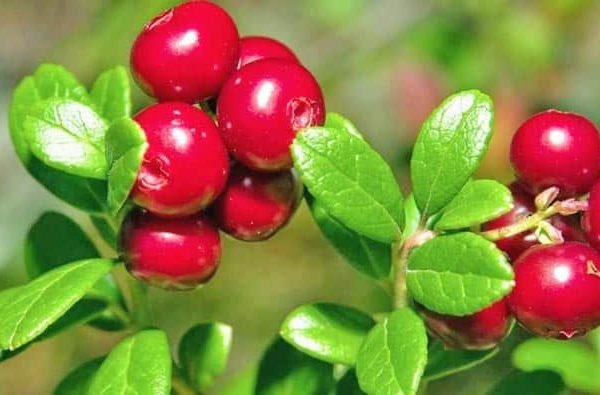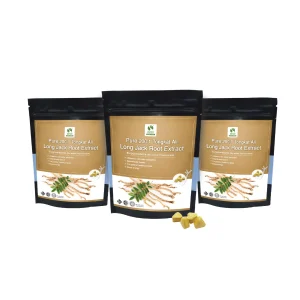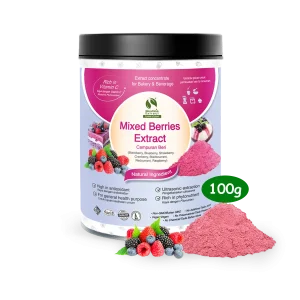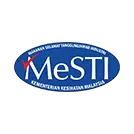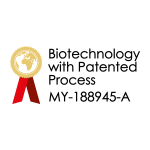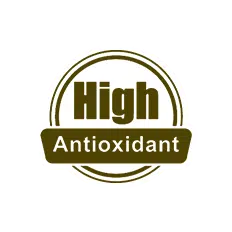By Hannah Bauman
Overview
The cranberry (Vaccinium macrocarpon, Ericaceae) plant is a perennial shrub native to northeastern and north-central North America, though it has been cultivated in Chile, China, and Europe.1-3 A similar species, V. oxycoccos (small cranberry), is found in northern North America, northern Europe, and Asia. Vaccinium macrocarpon is found in bogs and swampy, low-lying areas. The plant produces vines that can grow up to six feet long and have small, evergreen leaves. In late spring to early summer, the vines produce showy flowers that are pink or white, which in turn produce dark red, tart, ovoid fruits. The flowers attract bees, the leaves are larval food for the bog copper butterfly, and the fruits are eaten by birds and small mammals.
Historical and Commercial Uses
Native American tribes including the Iroquois, Ojibwe, and Algonquin, among others, used cranberry fruits primarily as a food product and stored the dried berries for winter provisions and trade.4 Dried cranberries were used in pemmican, a food product made for long-term storage made of dried meat, dried fruit, and animal fat.5 Cranberry fruits were also used medicinally for wound healing, fever, and swelling, and the First Nation Innu peoples of western Canada used an infusion of the branches for pleurisy (inflammation of the tissue that lines the chest wall).4,6 According to a global survey from 2013, cranberries frequently are used during pregnancy to prevent urinary tract infections (UTIs).7 This use was most prevalent in respondents from eastern Europe.
Native peoples in North America have cultivated and used cranberries for at least 12,000 years.6 European colonists began cultivating them in the early 19th century, and by 1885, almost 4,000 acres were under cultivation in the Cape Cod area of Massachusetts. Currently, there are approximately 40,000 acres under cultivation in North America, which supplies 90% of the global cranberry market. However, small amounts are also produced in Chile, followed by China and Europe.2,3
In 2020, cranberry dietary supplements were the third-highest selling supplement product in the mainstream retail channel and 14th in the natural channel, with total annual sales of more than $101 million and $7 million, respectively.8
Phytochemicals and Constituents
Cranberry fruits contain high amounts of dietary fiber, vitamin C, anthocyanins, ellagic acid, and quercetin.2,9 However, it is the proanthocyanidins (PACs) that are the focus of most modern research on the benefits of cranberry. The berries have unusually high concentrations of both anthocyanins and PACs compared to other fruits, and both types of compounds are also present in cranberry juice.5
PACs are plant constituents that have antioxidant, astringent, and anti-inflammatory activities and may help protect healthy cells from damage from oxidative stress. Cranberries contain A-Type PACs that are not commonly found in other fruits, and these unique PACs may be responsible for cranberry’s ability to inhibit bacterial adhesion. Vitamin C enhances the anti-inflammatory effect of PACs, which supports a healthy cardiovascular system and can reduce the risk of certain cancers and blood clots.10 PACs are also responsible for the tart taste of the berries.
Cranberries also contain high amounts of flavonols including kaempferol. Flavonol content in cranberries ranges from 200 mg/kg to 400 mg/kg of fresh berries, which is almost twice as high as the flavonol content in pomegranate (Punica granatum, Lythraceae) or grape (Vitis vinifera, Vitaceae).5 Processing conditions, including light, oxygen, and heat, can affect the total phenolic compounds in cranberry products, and the highest concentrations of these compounds are present in fresh or frozen berries.2
| Compound Type | Compound | Plant Part | Activities |
|
Anthocyanins |
Cyanidin-3-O-galactoside, cyandin-3-O-glucoside, cyanidin-3-O-arabinoside, peonidin-3-O-galactoside, peonidin-3-O-arabinoside | Fruit | Anti-inflammatory |
| Flavonol | Hyperoside, kaempferol-3-O-galactoside | Fruit | Anti-inflammatory, antimicrobial, chemopreventive |
| Flavan-3-ol | Epicatechin | Fruit | Antioxidant, anti-inflammatory, insulin regulator |
| Organic acid | Citric acid, malic acid | Fruit | Antimicrobial |
| Phenolic compound | Ellagic acid | Fruit | Antibacterial, antioxidant, antiviral, chemopreventive |
| Phenolic compound, hydroxycinnamic acid | Caffeic acid, coumaric acid, ferulic acid | Fruit | Antioxidant, cytoprotective |
| Procyanidin | Procyanidin A2, epicatechin-(4→8, 2→O→7)-epicatechin-(4→8)-epicatechin, epicatechin-(4→6)-epicatechin-(4→8, 2→O→7)-epicatechin | Fruit | Anti-adhesive |
Modern Research and Potential Health Benefits
Given the anti-inflammatory effects of PACs and anthocyanins, cranberry has been heavily studied for chronic inflammatory conditions. However, the most common use of cranberry for human health is the prevention of UTIs.
Antibacterial Activities: Ulcers and UTIs
Stomach ulcers, also known as gastric or peptic ulcers, are open sores that develop in the lining of the stomach. Infection with Helicobacter pylori bacteria is one cause of these ulcers. Cranberry products have shown the ability to prevent bacterial adhesion, which may help prevent H. pylori-induced ulcers.2 In addition, cranberry juice has been shown to reduce harmful bacteria in the stomach and alter gut flora in a beneficial manner.13
Certain populations are more susceptible to recurrent UTIs, including children and people who are elderly, pregnant, or wearing a catheter. A systematic review of cranberry products for UTIs in these vulnerable populations found that, overall, cranberry supplementation was associated with a 30% decrease in risk of recurrent UTIs compared to placebo. As in the case of peptic ulcers, this effect is believed to be due to the ability of PACs to inhibit bacterial adhesion; for UTIs, the main bacteria of concern for infections are Escherichia coli.14
In children, cranberry products were found to be superior to placebo and comparable to antibiotic intervention in preventing recurrent UTIs.15 As antibiotic resistance continues to grow, non-antibiotic interventions for minor conditions will help ensure that current antibiotics remain effective.
For adult patients wearing catheters, supplementation with a standardized cranberry extract (Anthocran® Phytosome®; Indena S.p.A; Milan, Italy) with 36 mg of PACs per 120 mg tablet was associated with a decrease in UTI symptoms compared to placebo and an active control (nitrofurantoin).16 Patients who took the cranberry supplement had fewer instances of hematuria (blood in the urine) and lower bacteria levels in the urine compared to those who received a placebo, and no patient in the active group reported a UTI in the three months following the study.
Inflammatory Conditions
Compounds in cranberry have shown benefits for the reduction of cardiovascular disease (CVD) risk and protection against lipoprotein oxidation.2 Hydroxycinnamic acids and flavonoids in cranberry can reduce the oxidation of low-density lipoprotein cholesterol, which is associated with atherosclerosis. In addition, the consumption of cranberry juice can significantly raise serum antioxidant levels for up to seven hours.
In a randomized, placebo-controlled crossover trial, overweight or obese middle-aged adults with elevated blood pressure drank either 500 mL of a cranberry drink that contained 27% cranberry juice or a placebo beverage. Cranberry juice supplementation was associated with a significant reduction in diastolic blood pressure, with a more pronounced effect in patients who were overweight.17
Gingivitis, an inflammatory condition caused by bacteria living in dental plaque, is linked to an increased risk of other chronic inflammatory disease such as CVD, diabetes, and chronic kidney disease.18 Cranberry, is thought to benefit both gingivitis and these other conditions. Patients with gingivitis who consumed a cranberry beverage reported decreased gingival inflammation, plaque, and Streptococcus mutans bacteria compared to placebo.19 The authors of the study concluded that cranberry juice can improve symptoms of gingivitis without increasing the risk of cavities.
Consumer Considerations
Adulteration of cranberry supplements has been reported in the dietary supplement industry.20 Often, this occurs with the substitution of PACs from cranberry with those from other sources, such as peanut (Arachis hypogaea, Fabaceae) skin, grape (Vitis vinifera, Vitaceae) seed, maritime pine (Pinus pinaster, Pinaceae) bark, black bean (Phaseolus vulgaris, Fabaceae) skin, and others.
Nutrient Profile
Per 100 g of cranberries9
Macronutrients:
46 calories
0.5 g protein
12 g carbohydrates
0.1 g fat
Secondary Metabolites:
Very good source of:
Vitamin C: 14 mg (15.6% DV)
Dietary Fiber: 3.6 g (12% DV)
Manganese: 0.27 mg (11.7% DV)
Good source of:
Vitamin E: 1.32 mg (8.8% DV)
Copper: 0.06 mg (6.7% DV)
Pantothenic acid (Vitamin B5): 0.3 mg (6% DV)
Also provides:
Vitamin K: 5 mcg (4.2% DV)
Vitamin B6: 0.06 mg (3.5% DV)
Potassium: 80 mg (1.7% DV)
Riboflavin (Vitamin B2): 0.02 mg (1.5% DV)
Magnesium: 6 mg (1.4% DV)
Iron: 0.2 mg (1.1% DV)
Trace amounts:
Phosphorus: 11 mg (0.9% DV)
Zinc: 0.09 mg (0.9% DV)
Thiamin (Vitamin B1): 0.01 mg (0.8% DV)
Niacin (Vitamin B3): 0.1 mg (0.6% DV)
Calcium: 8 mg (0.6% DV)
Vitamin A: 3 mcg (0.33% DV)
Folate (Vitamin B9): 1 mcg (0.3% DV)
|
Recipe: Cranberry Wassail Ingredients:
Directions:
|
References
- Vaccinium macrocarpon. Missouri Botanical Garden website. Available at: www.missouribotanicalgarden.org/PlantFinder/PlantFinderDetails.aspx?taxonid=279943&isprofile=0&. Accessed November 26, 2021.
- Skrovankova S, Sumcyzynski D, Mlcek J, Jurikova T, Sochor J. Bioactive compounds and antioxidant activity in different types of berries. Int J Mol Sci. 2015;16(10):24673-24706.
- Upton R, Brendler T, eds. Pharmacopoeia and Therapeutic Compendium: Cranberry fruit: Vaccinium macrocarpon Revised ed. Scotts Valley, CA: American Herbal Pharmacopoeia; 2016.
- Vaccinium macrocarpon. Native American Ethnobotany Database. Available at: http://naeb.brit.org/uses/search/?string=vaccinium+macrocarpon. Accessed November 27, 2021.
- Neto C, Vinson JA. Cranberry. In: Benzie IFF, Wachtel-Galor S, eds. Herbal Medicine: Biomolecular and Clinical Aspects. 2nd ed. Boca Raton, FL: CRC Press; 2011.
- The Cranberry. Cape Cod Cranberry Growers Association website. Available at: cranberries.org/history. Accessed November 29, 2021.
- Kennedy DA, Lupattelli A, Koren G, Nordeng H. Herbal medicine use in pregnancy: Results of a multinational study. BMC Complement Altern Med. 2013:13:355. doi: 10.1186/1472-6882-13-355.
- Smith T, Majid F, Eckl V, Morton Reynolds C. Herbal supplement sales in US increase by record-breaking 17.3% in 2020. HerbalGram. 2021;131:52-65. Available at: www.herbalgram.org/resources/herbalgram/issues/131/table-of-contents/hg131-mkrpt/. Accessed December 13, 2021.
- Cranberries, raw. USDA Agricultural Research Service website. April 2019. Available at: https://fdc.nal.usda.gov/fdc-app.html#/food-details/171722/nutrients. Accessed November 30, 2021.
- University of Rochester Medical Center website. Available at: www.urmc.rochester.edu/encyclopedia/content.aspx?contenttypeid=19&contentid=proanthocyanidins. Accessed November 30, 2021.
- Shukla R, Pandey V, Vadnere GP, Lodhi S. Role of Flavonoids in Management of Inflammatory Disorders. In: Watson RR, Preedy VR, eds. Bioactive Food as Dietary Interventions for Arthritis and Related Inflammatory Diseases. 2nd ed. New York, NY: Academic Press; 2019.
- Cardellina J, Gafner S. Cranberry Products Laboratory Guidance Document. Austin, TX: ABC-AHP-NCNPR Botanical Adulterants Prevention Program; November 2018.
- Gao T, Hou M, Zhang B, et al. Effects of cranberry beverages on oxidative stress and gut microbiota in subjects with Helicobacter pylori infection: A randomized, double-blind, placebo-controlled trial. Food Funct. 2021;12(15): 6878-6888. doi: 10.1039/d1fo00467k.
- Xie J-Y, Yang C, Xu D-F, Xia H, Yang L-G, Sun G-J. Consumption of cranberry as adjuvant therapy for urinary tract infections in susceptible populations: A systematic review and meta-analysis with trial sequential analysis. PLoS One. 2021;16(9):e0256992. doi: 10.1371/journal.pone.0256992.
- Meena J, Thomas CC, Kumar J, Raut S, Hari P. Non-antibiotic interventions for prevention of urinary tract infections in children: A systematic review and meta-analysis of randomized controlled trials. Eur J Pediatr. 2021;180(12): 3535-3545. doi: 10.1007/s00431-021-04091-2.
- Cotellese R, Ledda A, Belcaro G, et al. Anthocran® Phytosome®: Prevention of recurring urinary infections and symptoms after catheterization. J Diet Suppl. 2021:1-13. doi: 1080/19390211.2021.1972074.
- Richter CK, Skulas-Ray AC, Gaugler TL, Meily S, Petersen KS, Kris-Etherton PS. Effects of cranberry juice supplementation on cardiovascular disease risk factors in adults with elevated blood pressure: A randomized controlled trial. Nutrients. 2021;13(8):2618. doi: 10.3390/nu13082618.
- Mizutani K, Buranasin P, Mikami R, et al. Effects of antioxidant in adjunct with periodontal therapy in patients with type 2 diabetes: A systematic review and meta-analysis. Antioxidants. 2021;10(8):1304. doi: 10.3390/antiox10081304.
- Woźniewicz M, Nowaczyk PM, Kurhańska-Flisykowska A, et al. Consumption of cranberry functional beverage reduces gingival index and plaque index in patients with gingivitis. Nutr Res. 2018;58:36-45. doi: 10.1016/j.nutres.2018.06.011.
- Brendler T, Gafner S. Adulteration of cranberry (Vaccinium macrocarpon). Austin, TX: ABC-AHP-NCNPR Botanical Adulterants Prevention Program; 2017. Available at: www.herbalgram.org/resources/botanical-adulterants-prevention-program/adulterants-bulletins/cranberry-bulletin-december-2017/. Accessed November 26, 2021.
- Gilmore S. Cranberry Wassail. Cape Cod Cranberry Growers Association website. Available at: www.cranberries.org/recipe/cranberry-wassail. Accessed November 29, 2021.

